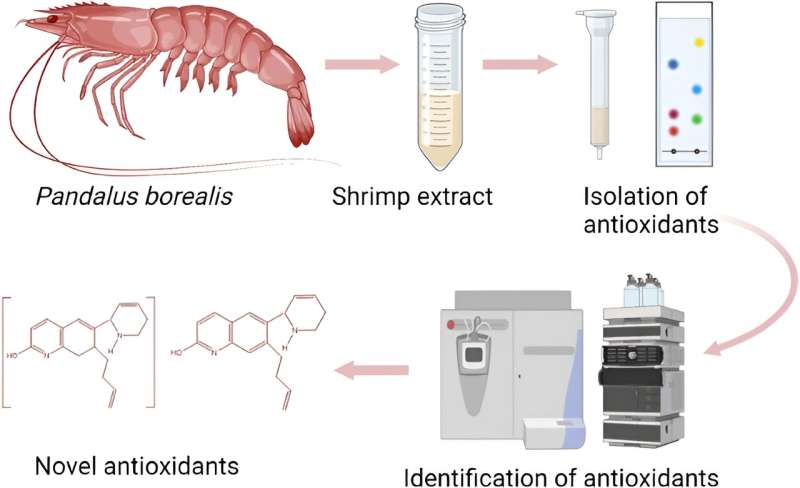This article has been reviewed according to Science X's editorial process and policies. Editors have highlighted the following attributes while ensuring the content's credibility:
fact-checked
proofread
Shrimp waste revolution: Unlocking potent antioxidants for health and sustainability

Shrimp are renowned for their high nutritional value, offering a rich source of proteins, amino acids, omega-3 fatty acids, minerals, and vitamins, as well as chitin and carotenoids. The increasing consumption of shrimp has led to a significant rise in by-products, such as heads, shells, and tails, which account for up to 50% of waste. This poses a substantial environmental challenge for fish processing industries. Shrimp shells, in particular, are rich in minerals, protein, and chitin. Recognizing the potential of these by-products, there has been a growing interest in converting them into value-added products.
In a new study featured in Food Production, Processing and Nutrition on 28 February 2024, researchers from Memorial University of Newfoundland have identified antioxidative compounds in Northern shrimp (Pandalus borealis), marking a significant breakthrough for the food and pharmaceutical industries. The research not only emphasizes the nutritional value of shrimp but also uncovers novel compounds with promising health benefits.
In this research, ethanol stood out as the premier solvent for isolating antioxidant elements from shrimp by-products, particularly the shells, which demonstrated superior levels of total phenolic content (TPC) and total carotenoid content (TCC). This finding not only underscores ethanol's extraction prowess but also unveils the substantial antioxidative qualities inherent in shrimp waste.
Through sophisticated chromatographic methods and mass spectrometry, the study unearthed phenolic compounds, achieving a significant milestone in the exploration of shrimp's nutritional value. The detailed analysis and isolation processes, involving silica gel column chromatography and thin-layer chromatography (TLC), led to the identification of groundbreaking compounds, notably 7-(3-butenyl)-2-hydroxy-6-(1,2,5,6-tetrahydropyridin-2-yl) quinoline.
This compound, along with its dihydroquinoline variant, reveals intricate antioxidative mechanisms within shrimp, paving the way for further scientific inquiry and potential health-related applications. By highlighting the rich, albeit underexploited, antioxidant sources in shrimp by-products, the study invites a broader examination of seafood waste, suggesting promising directions for future nutritional and pharmaceutical innovations.
Dr. Fereidoon Shahidi, a co-author of the study, emphasized the importance of these findings, stating, "The discovery of these unique heterocyclic phenolic compounds not only provides insights into the antioxidative properties of shrimp but also opens new avenues for the utilization of shrimp by-products, aligning with sustainable and waste-reducing practices in the seafood industry." He also emphasizes that structural conformation would benefit from 3D NMR and other modern techniques that are now commonplace since the work was originally carried out.
This breakthrough not only shines a light on the untapped potential of shrimp processing waste but also introduces novel compounds with significant implications for health, offering potential anti-inflammatory, anticancer, and anti-aging benefits. Moreover, it champions a sustainable approach to seafood processing, turning waste into valuable health-promoting agents.
More information: Akhile Collins Onodenalore et al, Unique heterocyclic phenolic compounds from shrimp (Pandalus borealis) and beyond, Food Production, Processing and Nutrition (2024). DOI: 10.1186/s43014-023-00215-3
Provided by TranSpread




















